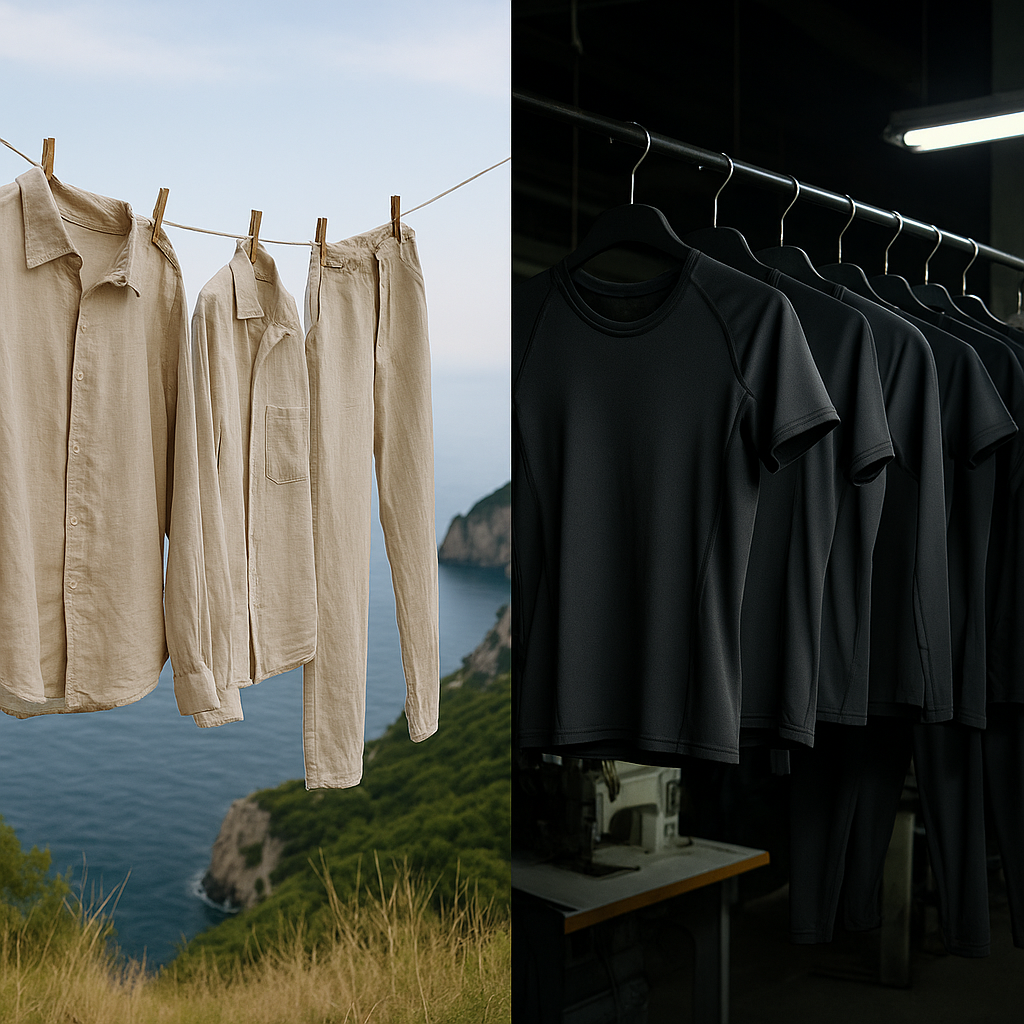
What We Used to Wear
Our ancestors didn’t wear “performance fabrics.” They wore what the earth provided. Clothes were made from flax, wool, cotton, hemp, or animal hides — all natural fibers that breathed with the body. Linen, for example, was used by ancient Egyptians because it kept the body cool and resisted bacteria. Wool kept people warm in cold climates without trapping moisture or odor. Even leather and hides allowed air to circulate, helping the skin maintain balance.
Today, most clothing is made from plastic.
The Rise of Synthetic Fabrics
In the last century, natural fibers were replaced by polyester, nylon, and spandex — fabrics that didn’t exist for most of human history. The appeal was obvious: cheaper, stretchier, and easy to wash. But the tradeoff was that these new materials were made from petroleum, the same raw material used for plastic bottles and industrial coatings.
On a microscopic level, synthetic fabrics behave differently from natural ones. Polyester and nylon trap heat, moisture, and bacteria against the skin. They interfere with the body’s ability to breathe and detoxify, and because they are insulators, they also hold static charge. Natural fibers like linen and cotton do not.
Most people can feel the difference without knowing why. It’s that subtle stress your body senses but can’t describe.
Your Skin Isn’t a Barrier — It’s Alive
Your skin isn’t just a wall that protects your organs. It’s an active, living organ that absorbs, releases, and communicates with your environment.
Natural fibers like cotton, linen, and wool support that process. They let moisture evaporate, regulate body temperature, and allow the skin’s microbiome to stay balanced. Synthetic fabrics do the opposite. They trap sweat and humidity, creating a breeding ground for bacteria and increasing transepidermal water loss — the way your skin loses hydration.
Research published in the Journal of Dermatological Science (Konda et al., 2019) found that synthetic fabrics can alter skin hydration, raise surface temperature, and increase irritation. The difference goes beyond comfort; it’s about how your skin functions.
Your body is designed to live in contact with nature, not wrapped in plastic.
The Static Load
Natural fibers like linen are electrically neutral. Synthetic ones, like polyester and nylon, build static charge through friction. That charge doesn’t just make your clothes cling — it creates an electrical field on your skin.
The human nervous system is electrochemical. It relies on tiny voltage shifts to regulate everything from sleep to muscle contractions. Studies in bioelectromagnetics suggest that static charge can influence skin voltage and even affect nervous system balance (Chevalier, 2015).
Our ancestors didn’t have this problem. They were grounded by what they wore and how they lived.
The Microplastic Problem
Synthetic fabrics don’t just affect your skin; they also break down into microplastics. Every time you wash polyester or nylon, millions of microscopic fibers are released into the water supply.
A study in Environmental Science & Technology (Napper & Thompson, 2020) found that a single load of laundry can release over 700,000 microfibers. These particles have now been found in human blood, lungs, and placentas (Leslie et al., 2022).
This means the fabrics you wear and wash don’t just stay on your body — they become part of your environment and, eventually, part of you.
Natural fibers like linen, cotton, and hemp, on the other hand, biodegrade. They don’t shed plastic or carry the same chemical additives that can disrupt hormones and metabolism.
How Different Fabrics Affect the Body
| Fabric | Source | Breathability | Static Charge | Biological Effects |
|---|---|---|---|---|
| Linen | Flax plant | Excellent | Neutral | Cooling, antimicrobial, supports healthy skin microbiome |
| Cotton | Cotton plant | High | Low | Breathable, comfortable, allows natural detoxification |
| Wool | Animal fiber | Moderate | Neutral | Thermoregulating, naturally antibacterial |
| Hemp | Hemp plant | High | Neutral | Resistant to mold and bacteria, biodegradable |
| Polyester | Petroleum-based | Poor | High | Traps sweat, increases bacterial growth, releases microplastics |
| Nylon/Spandex | Petroleum-based | Moderate | High | Restricts airflow, irritates skin, creates static buildup |
Relearning How to Dress
If you’ve already cleaned up your diet and skincare, clothing is the next step. The fabrics that touch your skin all day influence your health more than most people realize.
Start by checking your labels. Replace your most skin-contact items — underwear, socks, and bedding — with natural materials. Linen sheets are cooling and breathable. Organic cotton is soft, hypoallergenic, and easy to find. Wool keeps you warm without overheating.
Your body will feel the difference. The shift back to natural fibers is like reconnecting with an older version of yourself — one that evolved in rhythm with the planet, not the plastic industry.
Conclusion
Clothing used to protect and support human biology. Now, most of it isolates us from it.
Natural fibers let the body breathe, regulate temperature, and maintain balance with its environment. Synthetic ones insulate, trap, and disconnect. The closer we live to nature — from the food we eat to the fabrics we wear — the better our biology performs.
Your skin doesn’t need technology. It needs connection.
Resources:
- Daley, C. A., Abbott, A., Doyle, P. S., Nader, G. A., & Larson, S. (2010). A review of fatty acid profiles and antioxidant content in grass-fed and grain-fed beef. Nutrition Journal, 9(1), 10.
- Konda, S. G., et al. (2019). Effect of fabric type on skin physiology: A comparison of natural and synthetic textiles. Journal of Dermatological Science, 93(2), 110–118.
- Chevalier, G. (2015). The effect of grounding the human body on mood and physiology. Journal of Alternative and Complementary Medicine, 21(5), 295–303.
- Leslie, H. A., et al. (2022). Discovery and quantification of plastic particles in human blood. Environment International, 163, 107199.
- Napper, I. E., & Thompson, R. C. (2020). Release of synthetic microplastic fibres from domestic washing machines: Effects of fabric type and washing conditions. Environmental Science & Technology, 54(9), 5809–5816.
- Blicharska, E., et al. (2019). The effects of textiles on skin physiology and comfort. Textile Research Journal, 89(7), 1223–1235.
- Jafferany, M., & Franca, K. (2019). Psychodermatology: The Mind and Skin Connection. Clinics in Dermatology, 37(6), 658–664

Leave a Reply